Quantitative Evaluation of Hydrocarbon-Generation Intensity of Coal-Measure Mudstones in the Shanxi Formation on the Eastern Margin of the Ordos Basin: A Case Study of the Daning–Jixian Area
Abstract
1. Introduction
2. Geological Setting
3. Experimental Samples and Research Methods
3.1. Sample Information
3.2. Maturity Analysis
3.3. Rock Pyrolysis and TOC Determination
3.4. Gold Tube Pyrolysis Experiment
4. Results
4.1. Kerogen Types and Quality
4.2. Gold Tube Pyrolysis
4.2.1. Gaseous Hydrocarbon Yields
4.2.2. Kinetic Parameters
4.2.3. EasyRo–Temperature Conversion
4.3. Distribution Characteristics of Mudstones
4.3.1. Thickness Distribution
4.3.2. TOC Distribution
4.3.3. Ro Distribution
4.3.4. True Density
5. Discussion
5.1. Natural Gas Generation at Different Stages
5.2. Hydrocarbon-Generation Intensity Calculation
5.3. Differences in Hydrocarbon Generation and Controlling Factors
6. Conclusions
Author Contributions
Funding
Data Availability Statement
Acknowledgments
Conflicts of Interest
Abbreviations
| TOC | Total Organic Carbon |
| Ro | Vitrinite Reflectance |
| HGI | Hydrocarbon-Generation Intensity |
| OM | Organic Matter |
| HI | Hydrogen Index |
| PI | Production Index |
| C1–C5 | Gaseous Hydrocarbons |
| S1 | Free Hydrocarbons |
| S2 | Potential Hydrocarbons |
| Tmax | Maximum Pyrolysis Temperature |
| EasyRo | Easy Vitrinite Reflectance |
References
- Qiu, Z.; Song, D.; Zhang, L.; Zhang, Q.; Zhao, Q.; Wang, Y.; Liu, H.; Liu, D.; Li, S.; Li, X. The Geochemical and Pore Characteristics of a Typical Marine–Continental Transitional Gas Shale: A Case Study of the Permian Shanxi Formation on the Eastern Margin of the Ordos Basin. Energy Rep. 2021, 7, 3726–3736. [Google Scholar] [CrossRef]
- Li, Y.; Tang, S.; Zhang, S.; Xi, Z. In Situ Analysis of Methanogenic Pathways and Biogeochemical Features of CBM Co-Produced Water from the Shizhuangnan Block in the Southern Qinshui Basin, China. Energy Fuels 2020, 34, 5466–5475. [Google Scholar] [CrossRef]
- Wang, D.; Li, S.; Wang, R.; Li, B.; Pan, Z. Evaluating the Stability and Volumetric Flowback Rate of Proppant Packs in Hydraulic Fractures Using the Lattice Boltzmann-Discrete Element Coupling Method. J. Rock Mech. Geotech. Eng. 2024, 16, 2052–2063. [Google Scholar] [CrossRef]
- Dong, D.; Qiu, Z.; Zhang, L.; Li, S.; Zhang, Q.; Li, X.; Zhang, S.; Liu, H.; Wang, Y. Research Progress on the Shale Gas System of Marine-continental transitional Facies and New Discoveries. Acta Sedimentol. Sin. 2021, 39, 29–45. [Google Scholar] [CrossRef]
- Zhang, L.; Dong, D.; Qiu, Z.; Wu, C.; Zhang, Q.; Wang, Y.; Liu, D.; Deng, Z.; Zhou, S.; Pan, S. Sedimentology and Geochemistry of Carboniferous-Permian Marine-Continental Transitional Shales in the Eastern Ordos Basin, North China. Palaeogeogr. Palaeoclimatol. Palaeoecol. 2021, 571, 110389. [Google Scholar] [CrossRef]
- Kuang, L.; Dong, D.; He, W.; Wen, S.; Sun, S.; Li, S.; Qiu, Z.; Liao, X.; Li, Y.; Wu, J.; et al. Geological Characteristics and Development Potential of Transitional Shale Gas in the East Margin of the Ordos Basin, NW China. Pet. Explor. Dev. 2020, 47, 471–482. [Google Scholar] [CrossRef]
- Gu, Y.; Li, X.; Qi, L.; Li, S.; Jiang, Y.; Fu, Y.; Yang, X. Sedimentology and Geochemistry of the Lower Permian Shanxi Formation Shan 23 Submember Transitional Shale, Eastern Ordos Basin, North China. Front. Earth Sci. 2022, 10, 859845. [Google Scholar] [CrossRef]
- Zhang, Q.; Xiong, W.; Li, X.; Feng, C.; Qiu, Z.; Liu, W.; Li, X.; Xiao, Y.; Liu, D.; Yang, H. Discussion on Transitional Shale Gas Accumulation Conditions from the Perspective of Source-Reservoir-Caprock Controlling Hydrocarbon: Examples from Permian Shanxi Formation and Taiyuan Formation in the Eastern Margin of Ordos Basin, NW China. Energies 2023, 16, 3710. [Google Scholar] [CrossRef]
- National Energy Administration of China. Annual Report on Unconventional Gas; National Energy Administration of China: Beijing, China, 2024.
- Behar, F.; Vandenbroucke, M.; Tang, Y.; Marquis, F.; Espitalie, J. Thermal Cracking of Kerogen in Open and Closed Systems: Determination of Kinetic Parameters and Stoichiometric Coefficients for Oil and Gas Generation. Org. Geochem. 1997, 26, 321–339. [Google Scholar] [CrossRef]
- Kenneth, E.; Peters, A.K.B.; Walters, C.C. Petroleum Generation Kinetics: Single versus Multiple Heating-Ramp Open-System Pyrolysis. AAPG Bull. 2015, 99, 591–616. [Google Scholar] [CrossRef]
- Wang, Q.; Liu, W.; Meng, P.; Hu, J.; Wang, X.; Zhang, D.; Liu, J. Assessment the Gas Potential of Coal-Bearing Mudstones from Upper Paleozoic in Ordos Basin via Gold-Tube Pyrolysis. J. Nat. Gas Sci. Eng. 2021, 90, 103895. [Google Scholar] [CrossRef]
- Huang, W.; Zeng, L.; Pan, C.; Xiao, Z.; Zhang, H.; Huang, Z.; Zhao, Q.; Yu, S.; Xu, H.; Chen, C.; et al. Petroleum Generation Potentials and Kinetics of Coaly Source Rocks in the Kuqa Depression of Tarim Basin, Northwest China. Org. Geochem. 2019, 133, 32–52. [Google Scholar] [CrossRef]
- Liang, H.; Xu, G.; Xu, F.; Fu, D.; Liang, J.; Yu, Q.; Wang, D. Oil Generation of Lacustrine Type II Shale: A Case Study of the Shahejie Formation, Laizhou Bay Sag, Bohai Bay Basin (China). J. Pet. Sci. Eng. 2020, 195, 107839. [Google Scholar] [CrossRef]
- Xu, H.; Ding, X.; Luo, Z.; Liu, C.; Li, E.; Huang, P.; Yu, S.; Liu, J.; Zou, Y.; Pan, C. Confined Pyrolysis for Simulating Hydrocarbon Generation from Jurassic Coaly Source Rocks in the Junggar Basin, Northwest China. Energy Fuels 2017, 31, 73–94. [Google Scholar] [CrossRef]
- He, Q.; Chen, S.; Li, S.; Guo, B.; Lu, J.; Li, Y.; Li, X.; Zhao, L.; Ma, Z. Organic Geochemical Characteristics and Hydrocarbon Generation Mechanism of Marine-Continental Transitional Organic-Rich Shale: A Case Study from the Shanxi Formation in the Eastern Margin of the Ordos Basin. J. Pet. Sci. Eng. 2022, 219, 111116. [Google Scholar] [CrossRef]
- Wang, Z.; Zhou, N.; Lu, S.; Liu, Y.; Lin, L.; Liu, Y.; Song, B. Generation, Accumulation, and Distribution of Upper Paleozoic Tight Sandstone Gas in the Northeastern Margin of the Ordos Basin. Mar. Pet. Geol. 2023, 156, 106463. [Google Scholar] [CrossRef]
- Anees, A.; Zhang, H.; Ashraf, U.; Wang, R.; Liu, K.; Abbas, A.; Ullah, Z.; Zhang, X.; Duan, L.; Liu, F.; et al. Sedimentary Facies Controls for Reservoir Quality Prediction of Lower Shihezi Member-1 of the Hangjinqi Area, Ordos Basin. Minerals 2022, 12, 126. [Google Scholar] [CrossRef]
- Tang, X.; Zhang, J.; Ding, W.; Yu, B.; Wang, L.; Ma, Y.; Yang, Y.; Chen, H.; Huang, H.; Zhao, P. Reservoir and Gas-Bearing Properties of Upper Paleozoic Marine-continental transitional Shale in the Southeastern Ordos Basin. Earth Sci. Front. 2016, 23, 147–157. [Google Scholar] [CrossRef]
- Huang, L.; Liu, C.; Liu, Y.; Zhou, Y.; He, F.; Wang, Z.; Zhang, Y.; Guo, B.; Liang, C. Development model of vertical stratification for the strike-slip fault in the Ordos Basin and its significance. Sci. China Earth Sci. 2025, 68, 1497–1510. [Google Scholar] [CrossRef]
- Zheng, D.; Pang, X.; Jiang, F.; Liu, T.; Shao, X.; Li, L.; Huyan, Y.; Guo, F. Reservoir-Forming Characteristics and Physical Simulation of Tight Gas in the Linxing Area, Ordos Basin. Oil Gas Geol. 2020, 41, 744–754. [Google Scholar]
- Huang, L.; Liu, C.; Wang, Z.; Zhou, Y.; He, F.; Liu, Y.; Huang, Y. An alternative formation mechanism for strike-slip fault in stable intracratonic basin. J. Struct. Geol. 2025, 191, 105292. [Google Scholar] [CrossRef]
- Anees, A.; Zhang, H.; Ashraf, U.; Wang, R.; Liu, K.; Mangi, H.N.; Jiang, R.; Zhang, X.; Liu, Q.; Tan, S.; et al. Identification of Favorable Zones of Gas Accumulation via Fault Distribution and Sedimentary Facies: Insights from Hangjinqi Area, Northern Ordos Basin. Front. Earth Sci. 2022, 9, 822670. [Google Scholar] [CrossRef]
- Bai, J.; Zhao, J.; Ren, Z.; Li, W.; Wang, K.; Li, X. Paleogeographic and Sedimentary Evolution of Meso–Neoproterozoic Strata in the Ordos Basin, Western North China Craton. J. Pet. Sci. Eng. 2022, 215, 110600. [Google Scholar] [CrossRef]
- Geng, J.-Z.; Qiu, K.-F.; Gou, Z.-Y.; Yu, H.-C. Tectonic Regime Switchover of Triassic Western Qinling Orogen: Constraints from LA-ICP-MS Zircon U–Pb Geochronology and Lu–Hf Isotope of Dangchuan Intrusive Complex in Gansu, China. Geochemistry 2017, 77, 637–651. [Google Scholar] [CrossRef]
- Wang, J.; Li, X.; Liu, H.; Deng, X.; Wanyan, R. Depocenter Migration of the Ordos Basin in the Late Triassic and Its Controls on Shale Distribution. Interpretation 2017, 5, SF81–SF98. [Google Scholar] [CrossRef]
- Wei, Z.; Wang, Y.; Wang, G.; Zhang, T.; He, W.; Ma, X.; Yu, X. Enrichment Mechanism of the Upper Carboniferous-Lower Permian Transitional Shale in the East Margin of the Ordos Basin, China: Evidence from Geochemical Proxies. Geofluids 2020, 2020, 8867140. [Google Scholar] [CrossRef]
- Zhang, L.; Zhao, Q.; Peng, S.; Qiu, Z.; Feng, C.; Zhang, Q.; Wang, Y.; Dong, D.; Zhou, S. Paleoenvironment and Organic Matter Accumulation Mechanism of Marine-continental transitional Shales: Outcrop Characterizations of the Carboniferous–Permian Strata, Ordos Basin, North China. Energies 2021, 14, 7445. [Google Scholar] [CrossRef]
- Wei, Z.; Wang, G.; Wang, Y.; Ma, X.; Zhang, T.; He, W.; Yu, X. Geochemical and Geological Characterization of Marine-continental Transitional Shale: A Case Study in the Ordos Basin, NW China. Acta Geol. Sin. Engl. Ed. 2020, 94, 809–821. [Google Scholar] [CrossRef]
- Fu, C.; Du, Y.; Song, W.; Sang, S.; Pan, Z.; Wang, N. Application of automated mineralogy in petroleum geology and development and CO2 sequestration: A review. Mar. Pet. Geol. 2023, 151, 106206. [Google Scholar] [CrossRef]
- Fu, C.; Kou, X.; Du, Y.; Jiang, L.; Sang, S.; Pan, Z. Experimental Study of Supercritical CO2-H2O-Coal Interactions and the Effect on Coal Spontaneous Imbibition Characteristics. Fuel 2025, 383, 133888. [Google Scholar] [CrossRef]
- Liang, H.; Xu, F.; Grice, K.; Xu, G.; Holman, A.; Hopper, P.; Fu, D.; Yu, Q.; Liang, J.; Wang, D. Kinetics of Oil Generation from Brackish-Lacustrine Source Rocks in the Southern Bohai Sea, East China. Org. Geochem. 2020, 139, 103945. [Google Scholar] [CrossRef]
- Handhal, A.M.; Al-Abadi, A.M.; Chafeet, H.E.; Ismail, M.J. Prediction of Total Organic Carbon at Rumaila Oil Field, Southern Iraq Using Conventional Well Logs and Machine Learning Algorithms. Mar. Pet. Geol. 2020, 116, 104347. [Google Scholar] [CrossRef]
- Li, E.; Ma, W.; Li, J.; Ma, X.; Pan, C.; Zeng, L.; Wang, M. Thermal Simulation Study of Coal-Derived Hydrocarbon Generation from the Jurassic in the Southern Junggar Basin. Geoscience 2022, 36, 1313–1323. [Google Scholar] [CrossRef]
- Yao, P.; Zhang, J.; Lv, D.; Vandeginste, V.; Chang, X.; Zhang, X.; Wang, D.; Han, S.; Liu, Y. Effect of water occurrence in coal reservoirs on the production capacity of coalbed methane by using NMR simulation technology and production capacity simulation. Geoenergy Sci. Eng. 2024, 243, 213353. [Google Scholar] [CrossRef]
- Fu, C.; Xu, X.; Du, Y.; Kou, X. Experimental Study on the Influence of Pore Structure on Spontaneous Imbibition in Marine Black Shale. Capillarity 2024, 10, 57–72. [Google Scholar] [CrossRef]
- Xing, H.; Du, Y.; Fu, C.; Pan, Z.; Wang, Z.; Ma, J.; Gao, W.; Ma, L. Effects of ScCO2-H2O on the Macromolecular Structure and Adsorption Characteristics of Low-Rank Coal in the Ordos Basin. Fuel 2026, 405, 136410. [Google Scholar] [CrossRef]
- Wang, L.; Du, Y.; Wu, G.; Fu, X.; Xu, C.; Pan, Z. Application of Nuclear Magnetic Resonance Technology in Reservoir Characterization and CO2 Enhanced Recovery for Shale Oil: A Review. Mar. Pet. Geol. 2025, 177, 107353. [Google Scholar] [CrossRef]
- Lv, C.; Du, Y.; Fu, C.; Pan, Z.; Wang, Z.; Ma, J.; Gao, Y. Investigating the Mechanistic Effects of Supercritical CO2 on Tight Sandstone Mechanical Properties under Varying Water Compositions. Phys. Fluids 2025, 37, 043101. [Google Scholar] [CrossRef]
- Shao, X.-H.; Pang, X.-Q.; Li, M.-W.; Li, Z.-M.; Zhao, Y. Hydrocarbon Generation from Lacustrine Shales with Retained Oil during Thermal Maturation. Pet. Sci. 2020, 17, 1478–1490. [Google Scholar] [CrossRef]
- Wang, Q.; Zou, H.; Hao, F.; Zhu, Y.; Zhou, X.; Wang, Y.; Tian, J.; Liu, J. Modeling Hydrocarbon Generation from the Paleogene Source Rocks in Liaodong Bay, Bohai Sea: A Study on Gas Potential of Oil-Prone Source Rocks. Org. Geochem. 2014, 76, 204–219. [Google Scholar] [CrossRef]
- Tian, H.; Xiao, X.; Wilkins, R.W.T.; Tang, Y. An Experimental Comparison of Gas Generation from Three Oil Fractions: Implications for the Chemical and Stable Carbon Isotopic Signatures of Oil Cracking Gas. Org. Geochem. 2012, 46, 96–112. [Google Scholar] [CrossRef]
- Zhang, J.; Li, Y.; Liu, J.; Yan, X.; Li, L.; Shen, W. Modeling Hydrocarbon Generation of Deeply Buried Type III Kerogen: A Study on Gas and Oil Potential of Lishui Sag, East China Sea Shelf Basin. Front. Earth Sci. 2021, 8, 609834. [Google Scholar] [CrossRef]
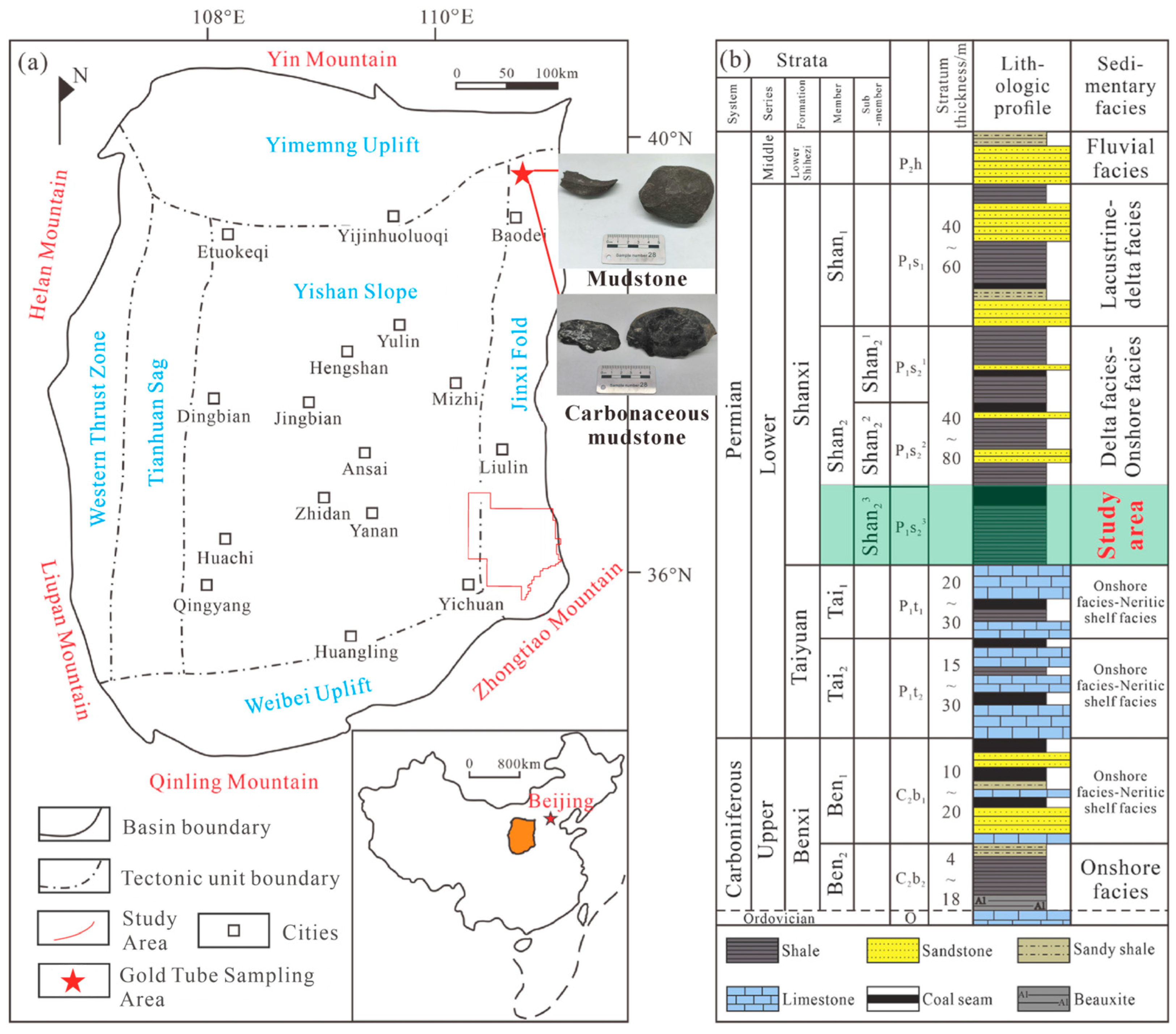
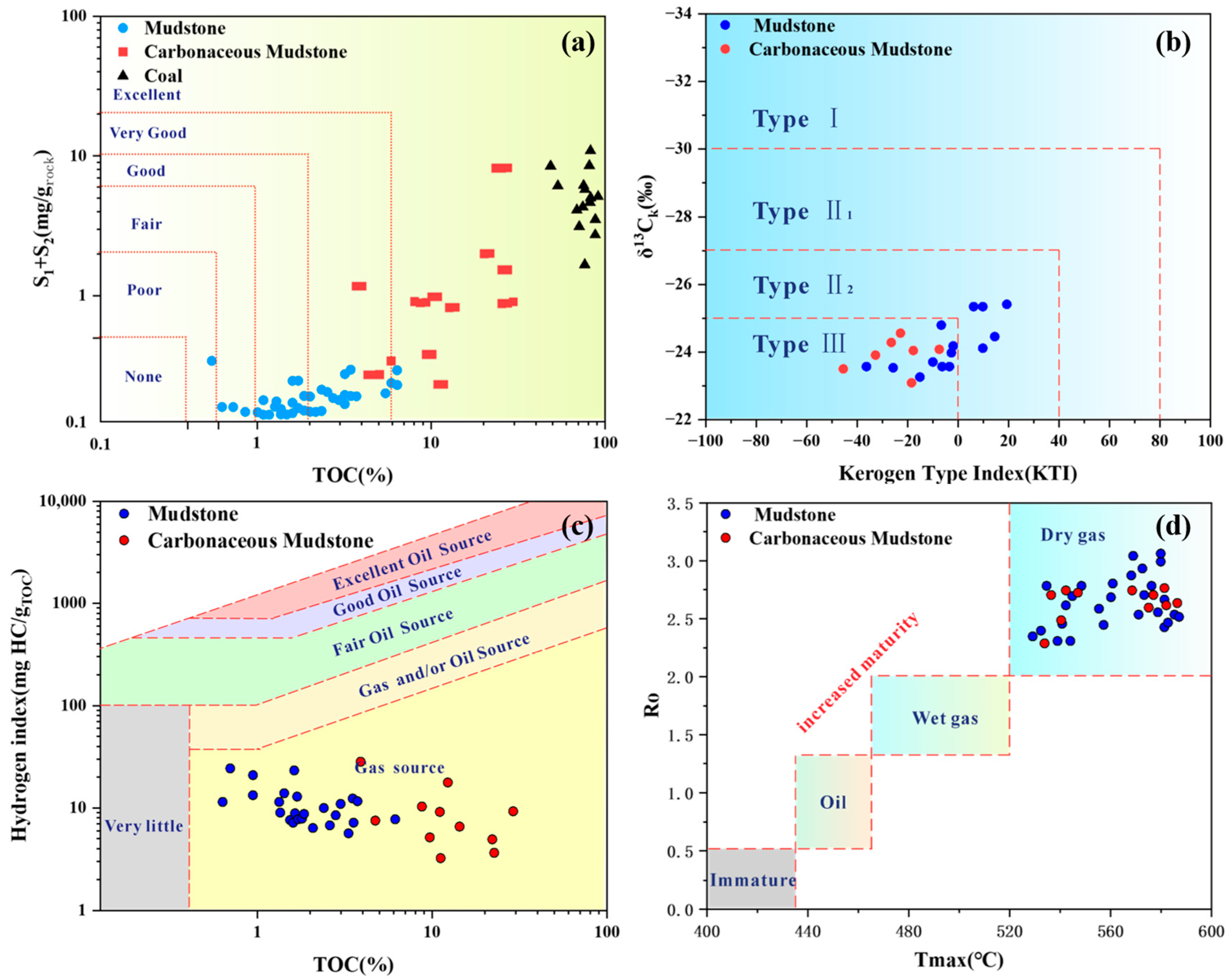

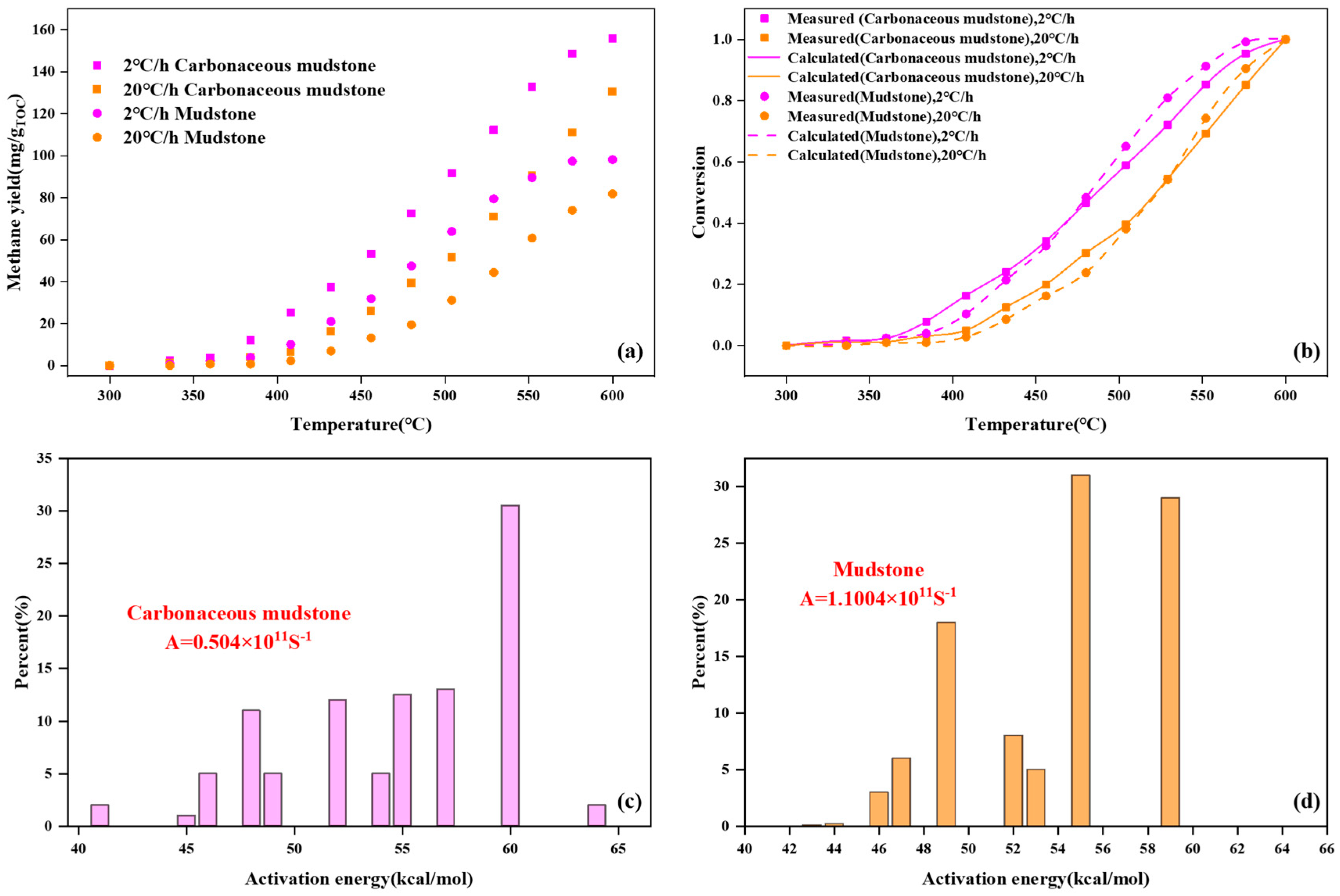
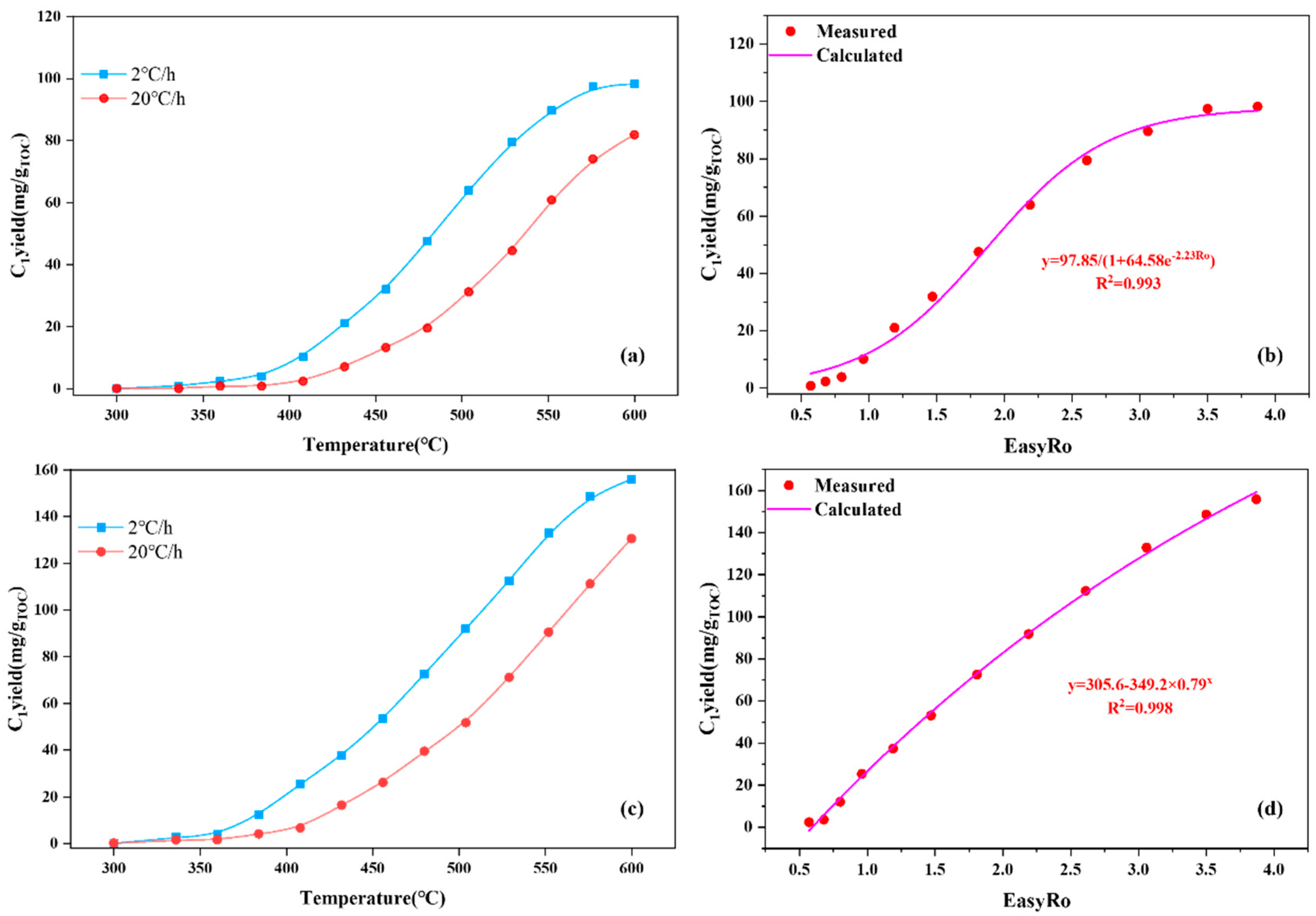
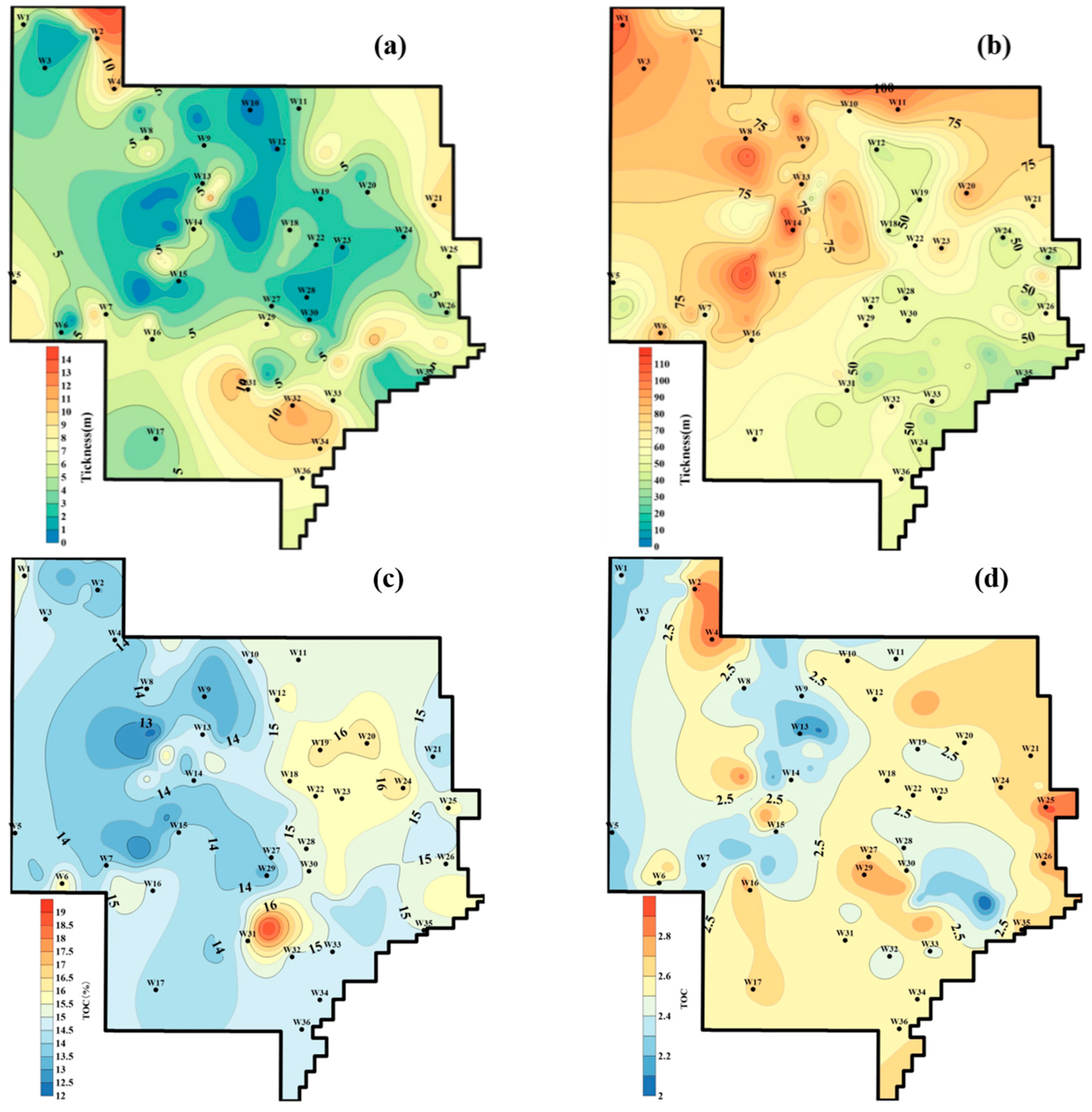
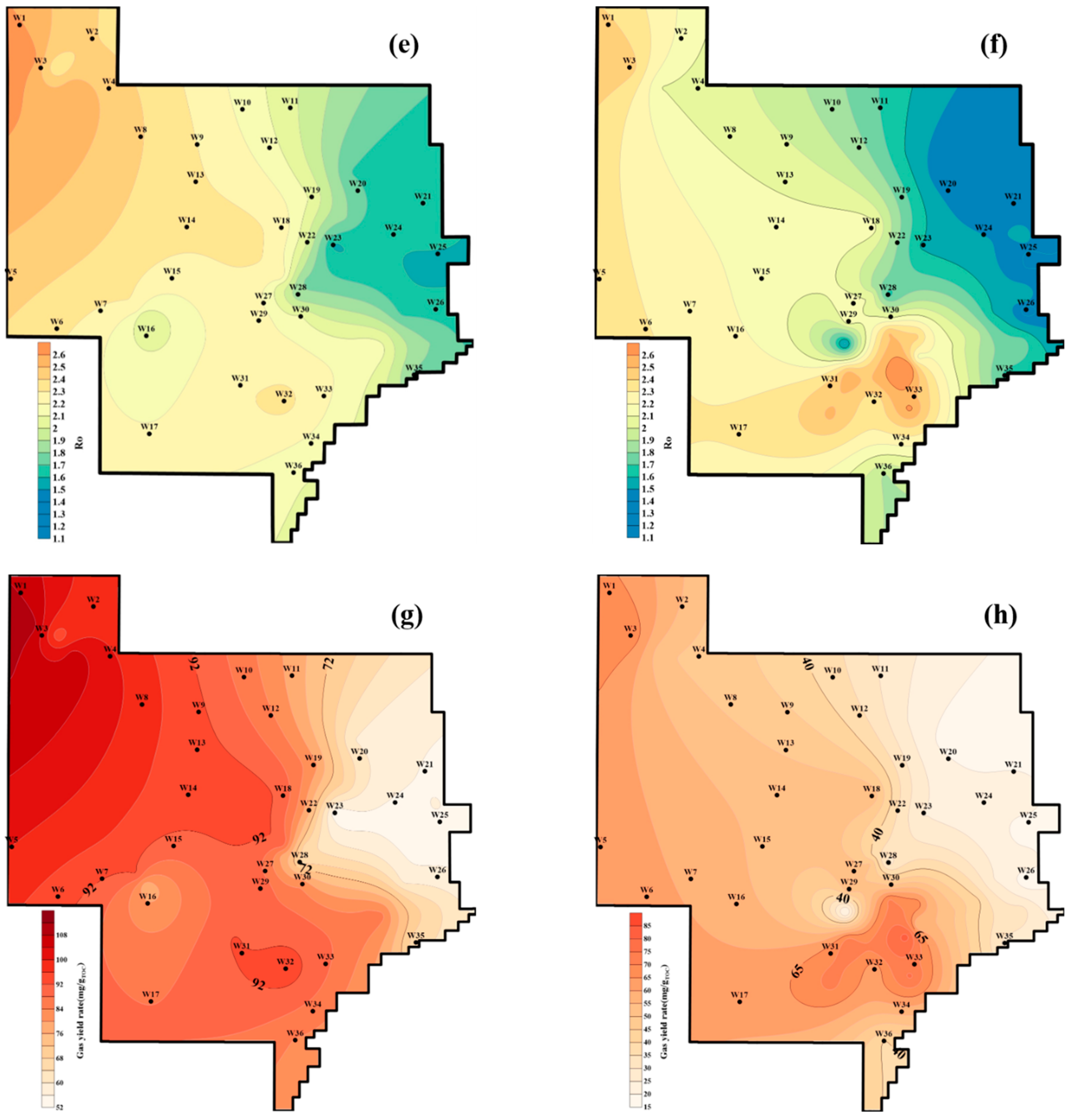
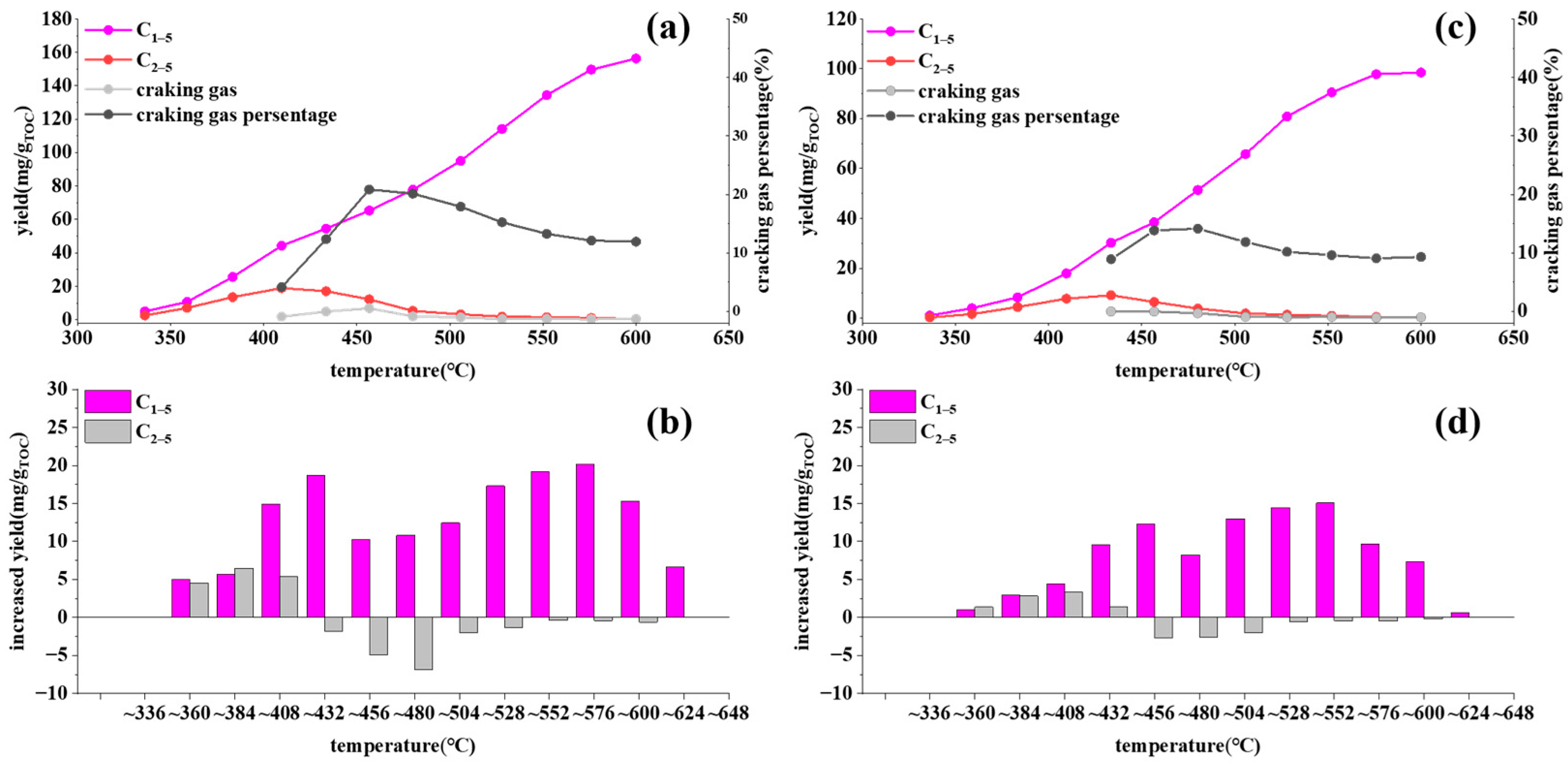

| Lithology | Mass (mg) | S1 (mg/g) | S2 (mg/g) | S1 + S2 (mg/g) | Tmax (°C) | TOC (%) | Ro (%) |
|---|---|---|---|---|---|---|---|
| Carbonaceous mudstone | 12.8 | 0.08 | 4.84 | 5.04 | 426 | 6.5 | 0.60 |
| Mudstone | 10.77 | 0.03 | 3.07 | 3.13 | 431 | 2.3 | 0.61 |
| Parameter | Carbonaceous Mudstone | Black Mudstone |
|---|---|---|
| TOC (%) | 14.20 ± 1.25 | 2.77 ± 0.35 |
| Ro (%) | 1.97 ± 0.31 | 1.83 ± 0.38 |
| Thickness (m) | 4.76 ± 2.15 | 67.20 ± 10.42 |
| Gas Yield (mg/g TOC) | 155.84 | 98.18 |
| HGI (108 m3/km2) | 1.64 | 2.18 |
Disclaimer/Publisher’s Note: The statements, opinions and data contained in all publications are solely those of the individual author(s) and contributor(s) and not of MDPI and/or the editor(s). MDPI and/or the editor(s) disclaim responsibility for any injury to people or property resulting from any ideas, methods, instructions or products referred to in the content. |
© 2025 by the authors. Licensee MDPI, Basel, Switzerland. This article is an open access article distributed under the terms and conditions of the Creative Commons Attribution (CC BY) license (https://creativecommons.org/licenses/by/4.0/).
Share and Cite
Song, J.; Zhang, K.; Hou, W.; Du, Y.; Qu, F.; Guo, S.; Xu, C.; Wang, M.; Zhang, Y. Quantitative Evaluation of Hydrocarbon-Generation Intensity of Coal-Measure Mudstones in the Shanxi Formation on the Eastern Margin of the Ordos Basin: A Case Study of the Daning–Jixian Area. Processes 2025, 13, 2786. https://doi.org/10.3390/pr13092786
Song J, Zhang K, Hou W, Du Y, Qu F, Guo S, Xu C, Wang M, Zhang Y. Quantitative Evaluation of Hydrocarbon-Generation Intensity of Coal-Measure Mudstones in the Shanxi Formation on the Eastern Margin of the Ordos Basin: A Case Study of the Daning–Jixian Area. Processes. 2025; 13(9):2786. https://doi.org/10.3390/pr13092786
Chicago/Turabian StyleSong, Jinggan, Kuaile Zhang, Wei Hou, Yi Du, Futao Qu, Sasa Guo, Chang Xu, Miao Wang, and Yijing Zhang. 2025. "Quantitative Evaluation of Hydrocarbon-Generation Intensity of Coal-Measure Mudstones in the Shanxi Formation on the Eastern Margin of the Ordos Basin: A Case Study of the Daning–Jixian Area" Processes 13, no. 9: 2786. https://doi.org/10.3390/pr13092786
APA StyleSong, J., Zhang, K., Hou, W., Du, Y., Qu, F., Guo, S., Xu, C., Wang, M., & Zhang, Y. (2025). Quantitative Evaluation of Hydrocarbon-Generation Intensity of Coal-Measure Mudstones in the Shanxi Formation on the Eastern Margin of the Ordos Basin: A Case Study of the Daning–Jixian Area. Processes, 13(9), 2786. https://doi.org/10.3390/pr13092786





